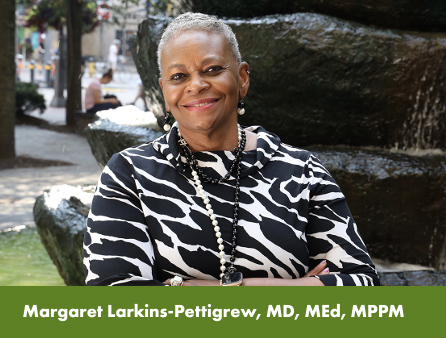
In 2022, the United States infant mortality rate was around 5.5 per 1,000 live births. However, the rate for Black infants was 10.9, for American Indian/ Alaska Natives it was 9.1, and for Native Hawaiian/ Pacific Islanders it was 8.5.
Preterm birth is one key cause of infant mortality. In 2022, on average in the United States, around 10% of births were preterm. Of these, preterm birth rates were highest for Black infants (14.6%), followed by American Indian/Alaska Natives (12.2%), Hispanics (10.0%), whites (9.4%) and Asian/Pacific Islanders (9.2%).
The U.S. Department of Health and Human Services Office of Minority Health found that Black infants are also at increased risk for low birthweight and related complications, sudden infant death syndrome and other health problems. How do physicians typically try to prevent these issues?
Many clinicians who understand the maternal and infant crisis we have faced for decades are already advocates for Black women. But there are many who practice unconscious and implicit bias based on learned stereotypes and perceived values. Ongoing education and conversations — involving all practicing clinicians, health care workers, supportive staff, doulas and family members — that challenge these biases are critical interventions that can save lives immediately.
Most evidenced-based studies reveal common threads of interventions that promise a new model of care, including:
- Better and earlier access to care
- Support for informed decision-making through community education, health literacy, social resources and community-based organizations
- Better research on minority health issues
- Elimination of racial bias and improvements in cultural humility and congruency among providers
In addition, Nationwide Children’s Collaboratory for Kids and Community Health offers six main strategies to tackle infant deaths:
- Target and address structural and interpersonal racism as fundamental drivers of infant mortality
- Address the social determinants of health across the life course to advance maternal and child health
- Advance policies that prevent poor birth outcomes and promote women’s health and wellbeing rights
- Improve provision of reproductive health care from preconception through one year of age
- Design and implement a connected and consistent care experience for mothers and babies
- Accelerate innovation, progress and accountability for health equity
The Office of Minority Health also reported that Black parents were twice as likely as white parents to receive late or no prenatal care. What barriers to care are Black parents likely to face during pregnancy and after their baby is born?
The post-partum period, or fourth trimester, has been shown to be the most dangerous period for a mother and baby. Socioeconomic barriers, lack of ongoing support and social determinants of health challenges are only a few of the variables that pose dangerous obstacles to a smooth transition to a healthy family. Psychological, emotional and behavioral health issues also increase the risk of poor outcomes.
What are some of the historical and systemic factors contributing to this crisis?
Our society has been shaped by systemic racism. It is all around us, in us and about us — all of us. The impact shows up in health care providers and in biased treatment algorithms leading to decisions that result in poor outcomes. Lack of trust from our patients and the communities we have vowed to serve complicates care, even if patients have access.
How did you feel about participating in the documentary “The Ebony Canal”? What did the process entail?
This film is a powerful addition to the transparent, honest and real-life experiences that people of minoritized populations face when presenting for equitable health care. It is a true testament to the power of partnership, listening and voices heard.
The opportunity to have a much-needed platform to advance the advocacy for Black women and unborn neonates was the highlight of this experience. Working with a passionate producer, Emmai Alaquiva, who is from my hometown of Pittsburgh, made it a more memorable experience. Over a two-year period, Emmai spent numerous hours interviewing several pregnant women, experts, clinicians and researchers across the United States.
What are some other ways people can educate themselves about the problem of preterm birth and infant mortality in the Black community?
“Born too soon” is a common statement used as maternal and fetal experts ponder why Black women have an increased risk of preterm labor, pre-eclampsia and other co-morbidities that result in both maternal and infant mortality and morbidity. Understanding the concepts of bondage, slavery and weathering — the effects of systemic oppression on the body — is a start to the foundation that will offer communities and learners a historical, psychosocial and pathophysiological window to various root causes of this dilemma.
Some resources include:
How can medical schools better prepare future physicians to provide more equitable care for Black parents and infants, during pregnancy and afterward?
Educating our future physician leaders to utilize historical and current data, implement best practices and understand their role in changing the trajectory for Black maternal and infant health must be integrated in our curriculum. This includes having uncomfortable conversations. Faculty members and other medical school educators must intentionally educate themselves to be prepared to lead these conversations. In the clinical years, we must continue to challenge our learners to think critically about sustainable solutions.
Data justice is the key to helping learners and healers practice at the top of their professions. Utilizing data from unbiased collection, analysis, creation and implementation programs will ultimately lead to better outcomes for all populations but specifically for minoritized populations. Research that is inclusive, recognizing the rapid changes in demographics, is starting to uncover the differences in risks, drug interactions and treatment regimens that will highlight racial inequities across socioeconomic domains. These findings will be key to interventions that affect the lives of Black women and Black birthing people who experience a three- to four-fold increase in fetal loss.